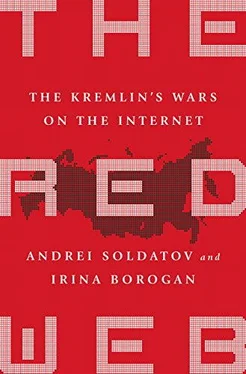Yuri Sinodov, thirty years old, had been a spacecraft engineer by training but made his career in the new world of digital media. He cofounded Roem.ru, a website specializing in web enterprises and social networks. By 2011 the site became the most insightful source in Russia on social networks and Internet companies. Sinodov was the owner and editor-in-chief of the site. [4] Andrei Soldatov and Irina Borogan, “The Russian State and Surveillance Technology,” OpenDemocracy , October 25, 2011, www.opendemocracy.net/od-russia/andrei-soldatov-irina-borogan/russian-state-and-surveillance-technology .
On April 28, 2011, Sinodov received a phone call from the FSB in which an officer from the FSB’s Information Security Center asked him to disclose the identity of a journalist who worked for him and had written a posting on the popular social media site, Odnoklassniki, or Classmates, about an obscure legal battle involving a private company. The FSB officer said that all he wanted was the name of the journalist, but Sinodov didn’t give it up. Instead, he asked the FSB for official confirmation that they had made the request. He soon received it in the form of an e-mail from “cybercrime@fsb.ru” that arrived with the FSB crest and was signed by Sergei Mikhailov, the head of one of the sections of the Information Security Center. [5] Yuri Sinodov, interview with authors, April 2011.
Five years later, in the aftermath of the DNC hacking scandal in December 2016, the FSB arrested Mikhailov. He was accused of spying for the Americans and thrown into Lefortovo, the famous KGB prison.
Sinodov then contacted the Directorate of Internal Security of the FSB, asking them whether this interest in his journalists was legal. The reply he received came again from the Information Security Center, which made the original request, this time signed by a first deputy director, establishing that the request was legitimate and was purely for reference. Sinodov still did not reveal the name. He next asked the General Prosecutor’s Office, which is separate from the FSB, whether the request was legitimate. Now the response was different: the procedure in question breached a law titled “On Operative-search Activity,” the Prosecutor General’s Office said, and the Directorate of the Information Security Center had been informed that it was not permitted to make such requests.
Sinodov immediately published his correspondence with the FSB and the General Prosecutor’s Office on his website. “I thought I had no right to publish FSB letters without the response from the Prosecutor’s Office, and now I’ve got it,” Sinodov recalled thinking at the time.
Sinodov believed that the FSB’s interest in his employee may have been an example of private firms using FSB officers to investigate leaks of confidential business information. This kind of working on the side—essentially corrupt moonlighting—was known to happen. “I think the company referred to in the post was trying to trace leaks of unofficial information about it,” Sinodov said. “The FSB itself has no interest in this. It is not a question of any national significance; it’s the company’s problem.”
But Sinodov’s story exposed something much more important than moonlighting. The FSB is divided into two large parts. The operations departments consist of counterintelligence, intelligence, counterterrorism, and other activity, whereas the support side of the organization includes such things as creating and providing special technical equipment and meeting other material needs. It was long believed that the Information Security Center belonged to the second part, but the FSB letters Sinodov published showed that the center was situated in the first, in the operations part, which is the most proactive, involved not only in the technical protection of computer networks but also in active operational surveillance, clandestine activity, and intelligence collection on the Internet. From this discovery it was clear who inside the FSB was working on social networks.
On the corner of Lubyanka Square and Myasnitsky Street is a blockish, looming structure that was once the KGB’s Computation Center, now housing the FSB Information Security Center. The center was initially responsible for protecting computer networks and tracking down hackers, but it had been greatly expanded. The duties now went beyond just protecting the government’s networks but also encompassed monitoring the Internet and the media closely. To do this the center used special analytical search software systems developed by Russian programmers. [6] On June 2, 2010, the service invited tenders for contract No.147/I/1–133, worth up to 450,000 rubles, for the procurement of software. The contract called for an information-analysis system called “Semantic Archive,” produced by the company Analytic Business Solutions.
One of the software systems was “Semantic Archive,” used by the security services and Ministry of the Interior to monitor open sources and the Internet, including the blogosphere and social networks. [7] Denis Shatrov, interview with authors, September 2011.
In 2011 the Semantic Archive team developed a special module for forums and blogs. It looked like a simple table on a screen with space to add names of specific blogs. When a user added the names, the system searched a wide swath of sources—not only the Internet but also such things as Russian law enforcement databases, court records, corporate records, blogs, and social networks—producing a report identifying links and connections, such as whether certain people went to the same school or were partners in a project, and sifting other places and events to tie them together.
The Semantic Archive engineers acknowledged there were drawbacks. Only a few dozen officers could use the module at a time. It was not only Semantic Archive that suffered from this problem; a lack of computing capacity crimped the security services from using these systems more widely. The size of the software packages, usually designed to suit a single department of about twenty- to twenty-five people, explains why the FSB and Interior Ministry bought dozens of different systems from different companies. Moreover, Russian programmers had not been able to overcome other problems. First, the monitoring systems were developed for searching structured information, such as databases, and only afterward adapted, some more successfully than others, for semantic analysis of the Internet, in which information can be more free-flowing. Second, the systems were designed to work with open sources and were technically incapable of monitoring closed accounts on Facebook or Twitter, so they could not be used to identify users and authors of posts on Facebook and elsewhere. Yet that was information the security services wanted. For that the FSB had to pick up a phone and call Sinodov.
As the planned presidential election in 2012 drew closer, both Putin and Medvedev were reluctant to say which of them would run. Both hesitated, and hesitated again. Time worked in Medvedev’s favor because Putin was losing popularity among bureaucrats and the elites. Sources inside the security services told us that even the FSB’s loyalty to Putin begun to waver as a group of generals attempted to contact Medvedev.
The reason was not political but generational. By 2011 the Russian bureaucracy at all levels was chock-full of Putin’s people—appointed in the early 2000s—who clogged channels of promotion. Putin’s friends and appointees occupied jobs in government, the news media, and state-controlled corporations. There was no upward mobility and no hope for any among a younger generation. The crisis hit even the security services, where all senior positions were occupied by those Putin selected from among people he personally knew from his time in the FSB in the 1990s. Tensions and mistrust between senior and midlevel officers caused a paralysis of leadership, and the friction between the different generations engendered passivity among midranking officers.
Читать дальше












